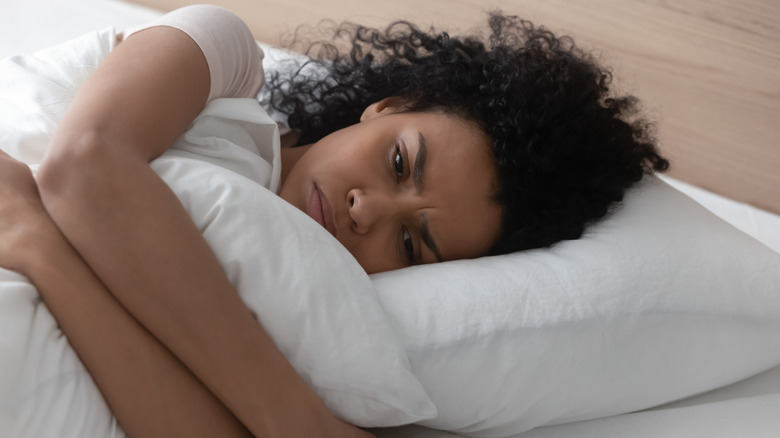Can Ovulation Spark Depressive And Anxious Feelings? Here's What We Know
On a typical day, maybe you enjoy some morning coffee, you power walk or take a cardio class, and after work, you're thrilled to connect with your friends or partner gallery opening followed by a nice dinner. If it's a warm night and the moon is out, you might stroll by the water before welcoming a refreshing night of sleep. Aside from the usual glitches and lessons in life, for two weeks out of every month, this is your norm: feeling energized and connected to your friends. Then, all hell breaks loose.
Many of us, and the Mayo Clinic estimates it's about 75% of menstruating people, experience PMS in the two weeks before menstruation — the familiar symptoms are crying jags, depressed mood, anxiety, breast tenderness, bloating, headaches, undeniable food cravings, insomnia, disrupted concentration, and maybe a lowered libido. It's mostly caused by hormonal fluctuations.
But for a much smaller percentage of people, estimated to be between one in 12 or one in 20, plummeting estrogen and progesterone levels in tandem with a potential genetic predisposition combine to create extreme a sense of overwhelm, irritability, anxiety, and depression. This is not PMS — it's PMDD, premenstrual dysmorphic disorder, and it's a mood disrupter that can undermine your career, relationships, and the enjoyment you get from life. Severity varies, but for some folks, symptoms can include experiencing life-ending ideations.
What to do if you think you have PMDD
You don't have to suffer through symptoms like these, and we encourage you to get the help you need. But don't self-diagnose — your first stop is the doctor's office to get a proper diagnosis.
Although PMDD is deeply connected with the endocrine system, it's also listed as a depressive disorder in the DSM-5, the Diagnostic and Statistical Manual used by psychiatrists and therapists to diagnose mental disorders. People with PMDD have at least five of these symptoms in the week before their period starts: feelings of hopelessness, marked mood swings, marked irritability, significant levels of anxiety, depression, difficulty concentrating, lethargy, and decreased appetite, to name. a few. Symptoms tend to improve when your period arrives and may disappear altogether when it's done.
Some people with PMDD may have pre-existing depression that then worsens for a couple of weeks, but others without depression notice a conspicuous difference in mood depending on where they are in their menstrual cycle.
Your next steps
If this sounds like you, don't worry. There are treatments. Typical PMDD treatments include a multi-pronged approach — regulating hormones with birth control pills, and the use of an SSRI anti-depressant. Then, eventually, there may be signs it's time to talk to your doctor about going off birth control. In a welcome signal of progress, the Cleveland Clinic takes it a step further by also advocating for dietary changes, reducing caffeine, adding vitamin B6 and magnesium, increasing regular exercise, and adding stress reduction techniques like breathwork and yoga.
Though they may not use the word holistic, the Cleveland Clinic employs functional medicine, which is a systems-based approach to medicine that searches for root causes of disease and treats the whole person, not just symptoms. Wherever you are in the world, consider working with functional medicine doctors to arrive at the most thorough diagnosis and treatment.
Even if you experience garden-variety PMS and not PMDD, the depressive and anxious feelings sparked by ovulation are real and uncomfortable. The diet, exercise, vitamins, and other recommendations noted above can be quite helpful in alleviating PMS symptoms so our lives can continue, including our work lives. As for how the workplace might evolve to better accommodate women's health without discrimination, should the U.S. follow Spain's paid 'menstrual leave'?


